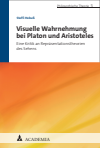Zusammenfassung
Platons und Aristoteles' Theorien des Sehens wurden rezeptionshistorisch oft im Rahmen der Dichotomie passives Empfangen vs. aktives Konstruieren gelesen. Die Studie legt anhand detaillierter Lektüren der einschlägigen Passagen dar, inwiefern nicht nur dieser Gegensatz nicht haltbar ist, sondern entfaltet eine Kritik an repräsentationalistischen Wahrnehmungstheorien. Während Platon die visuelle Wahrnehmung vor allem im Kontext seiner Erkenntnistheorie interessiert, geht es bei Aristoteles um eine Typologie der unterschiedlichen Wahrnehmungen und die Einordnung seiner Wahrnehmungstheorie in sein Denken der Mitte. Die Studie greift für die favorisierte Interpretation auf die sprachphilosophischen und texttheoretischen Arbeiten der Autorin zurück.
Abstract
Plato's and Aristotle's theories of vision have often been read within the dichotomy of passive receiving vs. active constructing. In giving detailed readings of the relevant passages, the study shows how not only this dichotomy is untenable, but also unfolds a critique of representationalist theories of perception. While Plato is interested in visual perception mainly in the context of his epistemology, Aristotle is concerned with a typology of different perceptions and giving a theory of perception in his thinking of the middle. The study draws on the author's work in the philosophy of language and text theory for the favoured interpretation.
Schlagworte
Aristoteles aesthetics Ästhetik Aristotle center Empfangen Erkenntnistheorie construing contrast Gegensatz Interpretation criticism Konstruieren epistemology Kritik history of reception philosophy of language Platon Plato Repräsentationstheorien Rezeptionsgeschichte receiving Sehen seeing text theory Sprachphilosophie theories of perception Texttheorie Typologie theories of representation typology Visuelle Wahrnehmung Wahrnehmungstheorien visual perception- 7–50 1. Einleitung 7–50
- 219–232 5. Literaturverzeichnis 219–232

